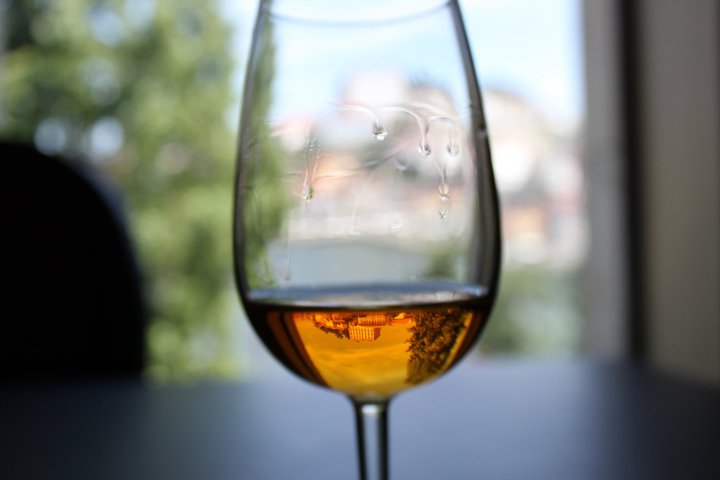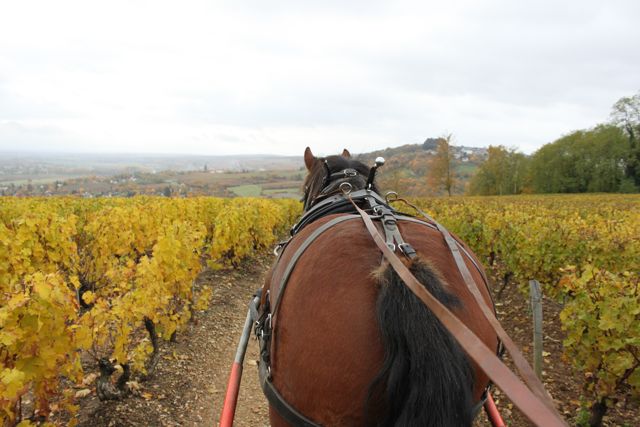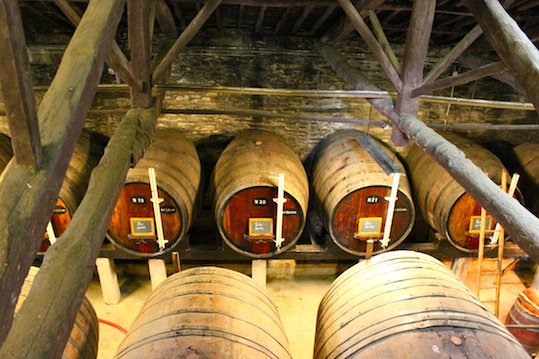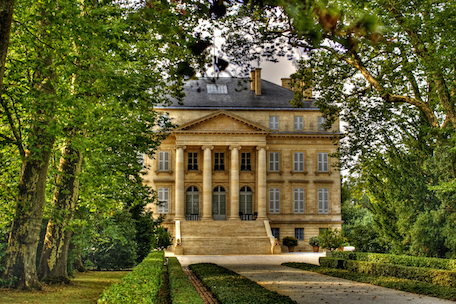Label – Luxury Cuvée

Label – Never judge a label by its wine.
Labels – Did you know that the text on all wine back labels is written by the same salad-munching, white & some red meat (with fish)-eating teetotaller?
Label Junkies – There is an argument that, in the interest of transparency, labels should be made more informative. It would certainly benefit the consumer. But the label is no guarantee of quality and I would argue that screeds of information on a bottle would obfuscate rather than clarify. We have become a country of label-readers instead of using our experiences, our knowledge and our memories to make discerning decisions. If you buy passively, you deserve to make mistakes. So read the papers, buy a reference book. Go to a reputable wine merchant. Have an idea what you’re looking for – it saves time and disappointment.
Lacrima/Lacryma – A grape that releases tears of poetry when aromatically beautiful and torrents of lachrymose disappointment when badly made.
Lafite – A man was arrested for coming out of Tesco’s having shoplifted two bottles of Chateau Lafite. He asked for the charge to be reduced to taking a single bottle as Tesco’s were doing a “two-for-one offer”.
Lagrein – A dark red grape from the Alto-Adige (although it can make serviceable pink wines.)
“Thanks to artisanal producers like Hofstätter and Georg Ramoser, I’m even becoming masochistically fond of Lagrein, the idiosyncratic indigenous red grape that looks as dark as Petite Sirah in the glass and tastes kind of like bitter zinfandel. Ask for it if you want to impress your wine store owner or your sommelier.” –Jay McInerney
Lambrusco, A digression concerning – It is spring and a middle-aged geezer’s fancy inevitably turns to vampire spit. I beg your pardon? Us proto-Nosferatus blinking in the shadows just aren’t sure whether our vinous preferences are Arfa or Marfa at this time of year. What to sink the old dentines into? There is a still a chill in the air so we’re not perky for pinky yet. Just-bottled whites can be sulphurous nostril enemas. Reds can be lean and cantankerous. Much cheap champagne is drainer. There is a style of wine, however, that would happily unite Klingons, Dick Swivellers, ardent neckgrazers and the King of old Dunfermline town in an orgy of uncritical guzzling. I invite you to cast aside your preconceptions and bring your lambruscos to the slaughter.
Emilia-Romagna, of course, is Lambrusco-shire. Ask for a glass of house red in any Bolognese tratt and, as likely as not, you’ll be given a beaker of unapologetically foaming purple-red liquid. Like so many wines Lambrusco has become adulterated in the translation – usually in the confected, sweetened shambrusco versions that have rocked up on our shores for so many years and populated the supermarket shelves. The more authentic, cultured styles from one of the of the better Emilian growers may not give one furiously to think, as Hercule Poirot would say, but they invariably deliver rasping, toothsome satisfaction.

Lambrusco is also one of those wines (think Provençale rosé, think Picpoul, think Txacoli) that trigger happy holiday memories. Magic is what you make of it. Victoria Moore describes how a glass of Lambrusco (bloody good Lambrusco it has to be said) whisks her on an imaginative journey:
“And if I only had a villa in Umbria with a terrace surveying a tangle of olive groves and cypress-ridged hills, it (the Lambrusco) would exactly fill that gap when the afternoon had faded but the evening has not properly begun…Perhaps that‘s why I like this Lambrusco so much – it makes me think of all these things.”
Lampreys – A surfeit of lampreys à la Bordelaise. A most excellent way to abuse your Château Palmer.
Land – The constant intimate link with the land which makes him love and desire it with a passion such as you might feel for someone else’s wife whom you care for and take in your arms but can never possess; that land which, after you have coveted it in such suffering for centuries, you finally obtain by conquest and make your own, the sole joy and light of your life. And this desire which had been built up over the centuries, this possession seemingly never to be achieved, explained his love for his own plot, his passion for land, the largest possible amount of land, the rich, heavy lump of soil you can touch and weigh in your hand. –Emile Zola – The Earth
Languedoc – The Languedoc is where the mustard is being cut vis-à-vis bang-for-buck cheapies (that’s not a sentence you read every day). And now great wines are being made in this region that stretches pretty well from Perpignan to Provence if I am allowed some p-p-poetic license. “The achingly beautiful countryside is an amphitheatre of small mountains clad in a sea of green, a forest of small trees and bushes and the familiar clumps of fragrant rosemary and thyme which captures the scented spirit of the high Languedoc.” You knows it, they grows it. Think ancient gnarly Carignan bushes, all nubbly and angular, the heart of the wine, sweet, svelte Grenache, all softness and spice, military Syrah with its firm backbone, shy Cinsault, palely loitering as a minor partner in the blend, and occasional Mourvèdre, the boisterous drum-beating cousin. Whites may be a tiny part of the production, but they are no less fascinating. Terret (Blanc & Gris), Grenache (Blanc & Gris), Muscat in fortified or dry form, Piquepoul Blanc, Rolle (aka Vermentino) and Roussanne.
Lapels – A fascinating coincidence observed the other day. I went to a trade tasting and everyone was wearing a badge with their name on it. They were all called HORECA. An extraordinary example of how the wine trade is one big family.
Lardo… and Lambrusco or Vermentino? There’s only one way to find out – FIGHT!!!
Lasers – to overtake manual sorting in hi-tech Bordeaux…Manual sorting tables will soon be a thing of the past as the top chateaux embrace €100,000 laser sorting technology. Grape surgeons, as they will be known from now on, will be using micro-surgery to remove individual pips. Any grape that does not measure up to expectations will be sent to the newly appointed Grapefinder General to be summarily sentenced and ceremonially burnt at the stake of Michel Rolland’s opinion.

Latour – In arguably the most important story of any millennium Latour has just overtaken Chateau Lafite in China as the preferred first growth to add to coca cola for that refreshingly claretty taste.
Latour-al thinking – the Pauillac-centric referencing of top Bordeaux wines in every discussion about wine. Thus all vintages will indexed in value according to those experienced on the left or right bank. If it doesn’t happen in Bordeaux it doesn’t exist and if Bordeaux doesn’t have an opinion about it, it ain’t worth knowing.
Laying Down – What customers feel in need of after seeing the mark-ups in certain West End restaurants.
Leaf Days – will supposedly cause wine to close in. So, in the way of an oxidative wine, it will show more structure, brighter acid and tannins. This can be good for older wines, and help to bring them back into balance. Also a decent day to drink bumptious fruit bombs, if you’d like to tone down that effusiveness.
Lebanon – Beshrew me, the tills are still alive with the sound of Musar. I’ll have a Beka’a’s dozen toot sweet.
Lees – Dregs? That’s what he sediment (famous piece of graffiti). Otherwise the draff that settles at the bottom of a fermentation vessel comprising dead yeast cells, skins and pips and insoluble tartrates – the stuff of wine itself. Wine can be left on the so-called fine lees to gain greater complexity of flavour. Lees stirring or batonnage (breaking up the thick sediment of lees) enables oxygen to reach the bottom layer of the wine and helps prevent the reduction of sulphur into the more noxious smelling hydrogen sulphide.
Leftovers –
Dear Deirdre D’Arcy,
For some reason I couldn’t finish a bottle of wine with my pretend boyfriend last night. What shall I do with the leftovers?
Yours ever,
Bridget Jones
Dear Ms Jones,
Depending on the wine I would propose several alternative courses of action. You can always cook with wine, although if you’re the Ms Jones I think you are, it won’t necessarily improve the flavour of that Pot Noodle. If the wine dregs are cheap Soave or Pinot Grigio or Cava of uncertain provenance I understand that they remove the stubbornest of stains from bath tubs and toilets. Do wear rubber gloves whilst using these chemicals though.
Yours,
Ms D’Arcy
Legerdemain – What separates sommeliers from the rest of mere mortals is their ability to tie a napkin around the neck of the bottle with panache and to project the wine into the glass. As a former sommelier myself I can testify to the awkwardness of pouring without placing the neck of the bottle on the rim of the glass for support. Cackhandedness, on the other hand, can take on epic proportions. My favourite story was of a young sommelier who was working her first shift in a trendy London restaurant. She popped the champagne cork too violently; it flew up, hit the mirrored glass ceiling which shattered and one giant shard plummeted towards a table where it sliced open the back of a nubile young woman’s dress. Which was a, as Robert Stephens used to intone in his plummiest voice: CATASTROPHE!

Legs (Tears, Arches) – having swirled your glass observe how the liquid clinging to the sides after the wine has settled. This viscosity may be due to the extract, the level of alcohol or the sugar content of the wine, or a combination of these factors. May be described as vast and trunkless if you are in poetic mood, or like Betty Grable’s for those with black-and-white memories. Legs have replaced tears and arches appear to have fallen out of favour. All arches, by the way, must be gothic.
Len de L’El or Loin de l’Oeil – derives its name from its appearance. The bunches are situated near the front of the branch, and have a long peduncle. As such, they are far from the eye (the bud) of both the branch and the bunch. A more whimsical version says that the bunches are far from the eye of the harvester, and thus some of them get left behind!
Very little is known about the history of this grape. It seems to have been present in the Gaillac region for a very long time. It was probably used in blends of sweet white wines which were very popular in England, Flanders and Holland in the 17th and 18th centuries. In the 19th century, it made up 30% of the blends of Gaillac white wines. Stupid Flanders. Sorry, was momentarily thinking of The Simpsons.
Let’s Get Metafizzical – A pop hymn to exclusive über-cuvées of pop.
Libation – Now used in a totally arch manner as in “I am about to open a bottle of Chateau Rougevin NV. Would you care for a small libation?”
Lie – French for lees. Also how the French pronounce the word meaning falsehoods.
Lies, Damned and Statistics – The wine industry dwells in a constant state of inebriation having swallowed hectolitres of facts and figures designed to prove a point by those who commissioned them in the first place.
Liebfraudmilch – A cash cow made of sugar syrup and undercooked supermarket intentions.
Lledoner – A small Welsh village where the hairy Grenache family lives on kebabs.
Llicorella – The neighbouring Welsh village to Lledoner and also the area near the foothills of Montsant (the Holy Mountain) where resides an almost otherworldly soil type that cannot be duplicated anywhere else on earth: Llicorella. This mix of decomposing dark slate and quartzite that developed in Paleolithic times is dark in colour but glitters in the sun from the high crystal content.
Local Wine –
“The Spanish wine, my God, it is foul, catspiss is champagne compared, this is the sulphurous urination of some aged horse.” –D.H. Lawrence, Letter From Parma to Rhys Davies

Loire –
“… the river that moves sideways, boldly challenging the psychic cartography which decrees that everything about France is aligned north to south.” –John Lanchester
…toutefois l’absorption de 184646 bouteilles de vin d’Anjou ne rendit pas sa langue moins habile… –Rabelais
Gustave Flaubert once wrote of the Loire valley: “The wind is mild without voluptuousness, the sun soft without ardour; the whole landscape pretty, varied in its monotony, light, gracious, but of a beauty which caresses without captivating, which charms without seducing, and which, in a word, has more common sense than grandeur and more spirit than poetry. It is France.”
Lollywater – Anything insipid and winegummy such as Beaulolly Nouveau and cochineal-hued “red” wines that merit, at most, a six month sell-by date. Also the wines that score 13.5/20 in Decanter Wine Challenges and are dubbed “inoffensive.”
Long/Length – the longer the better. What distinguishes a great wine from a good wine is the difference between the lengths of time that a wine persists on the palate after being swallowed. Or the length of time it takes to swallow a mark-up in some restaurants.
Loupiac – Crazily ordinary sweet wine.
Low Ugh-ahol wines – A dealcoholised wine has just been launched in Italy. Called Wine Zero the 0.5% “wine” is made from fermented juice that is then given a full lobotomy in a stainless steel vacuum. Following on from the local Pinot No-Grigio, Rusk-ati and Zero d’Avola this version quite rightly comes from all over the plains of Spain and is available in three colours; pale, utterly transparent and cochineal. There is also a Spanish-American oak-aged red marketed under Oak-a-hola! Label.
An advertising campaign called “Fear the mark of Zero” will launch the product. A sequel advert called “From Hero to Zero Point Five” will stress the wisdom of drinking wine that will only make you ill or crazy because of its incredibly bad taste.
The wines have been praised for stopping alcohol abuse by an Alcohol Awareness pressure group. “Who’s going to abuse alcohol, when you can abuse this bat’s piss so easily?” leered a spokesperson.
Said one local commentator: “There is a gap in the Italian market for wines like these and that gap is called the entrance to the town sewer”.

Library (also country houses, old furniture) – Old Rioja with its wonderful aromas of beeswax, floor polish and mahogany blush reminds one of a library of first editions in a country house where all the wooden furniture has been lovingly polished.
Library vintages – Wines from old vintages that wine merchants have been unable to sell and are now re-marketing as something rare and valuable.
Lifting Heavy Glass – I am wrist-averse to the tendonitis of certain ultra-super-premium brands in entombing their ipso-fatso mediocre wine in triple-thickness glass bottles with punts deep enough to conceal a small sommelier. When I see such pretentious bottles my eyes glaze over – literally.
Light bottles – Unbearable lightness of being
The world’s lightest bottle will be released into supermarket in early January next year. Pioneered in this country, apparently, it is 50% glass and 50% hot air and will automatically rise to the top shelves of the superstores.
Literature, References To Wine In – I am indebted to the late Bill Baker’s excellent essay in The Oxford Companion To Wine (edited by Jancis Robinson). He charts references from Chaucer and Shakespeare through Pepys, Smollett, Byron and Keats, Peacock and Thackeray and into the 20th century with Belloc, Goldsworthy, Waugh and Amis. Of course, getting drunk on wine has always been occupation in an idle hour and consolation in a distressed one. I particularly like the Dr Johnson quotation that “few people had intellectual resources sufficient to forgo the pleasures of wine. They could not otherwise contrive to fill the interval between lunch and dinner”. Bill also identifies the infuriating habit of Ian Fleming’s James Bond who keeps on referring to vintages of Dom Perignon and Taittinger that were never made, especially ironic when you consider the following piece of very roughly paraphrased dialogue from Diamonds Are Forever:
Thuggish baddy (not so cunningly disguised as waiter): Would you like your Chateau Mouton-Rothschild decanted now, sir?
Bond: No, I would prefer a claret.
T. B.: Very well, I will fetch you a claret.
Bond: Aha. If you were a real waiter you would know that Mouton-Rothschild is a claret.
Waiter explodes with a stick of dynamite between his legs
Littoral – Proximate to the shore. As in “This Muscadet littorally tastes of the sea”
Lush – Something pleasing or desirable as in “Cor! Do you see the legs on that Cote-Rotie? Lush! Also, one who has imbibed too much sauce and flirts wantonly – eg a peachy, buxom New World Chardonnay. You know what I’m talking about.
Luxembourg – Pass de Duchy on the de left hand side (of the road). On a clear day, from the terrace you can’t see Luxembourg at all… this is because a tree is in the way. (Alan Coren). Luxembourg has a long tradition of making wine (since late Roman times). Virtually all production is for white and sparkling, the major grape varieties being: Rivaner, Pinot Blanc, Auxerrois, Riesling, Pinot Gris and Gewürztraminer. The climate is one of the coolest in Europe for winemaking (rivalling England supposedly) and Luxembourg also has a clear-as-mad-mud cru classé system, worthy of the Circumlocution Office. Most wines are labelled as varietals. There is one covering appellation called Moselle Luxembourgeoise and tasting panels may rank superior wines as Vin Classes, Premier Crus and even Grands Premier Crus! This system has attracted criticism and a rival organisation called Domaine et Tradition which encourages local variation and expression and restricts yields.

Luxury Cuvée –Where wine is treated as commodity to be traded for massive profits, for the self-aggrandisement of rich collectors, institutions and, of course, the now-corporate chateaux. What’s in a name? Everything, apparently – the fine wines in question are becoming less affordable and less available. Virtual invisibility helps to foster desirability. Put it into perspective – wine is the juice of grapes and though certain wines possess qualities that elevate them to other levels, it is the richness of the hype that creates the demand, that transforms, for example, the often shockingly poor wine in champagne into a brute (sic) luxury commodity (if we are accepting a sharp dosage of reality), and that ranks vintages, and sustains the index-linked value of certain products beyond all logic or good taste.
The word luxury has pejorative overtones. Yet, where expense is the result of craftsmanship we won’t begrudge the price tag. Clos des Goisses, the spectacular single vineyard cuvée from Champagne Philipponnat, might be regarded as a special or exceptional cuvée, the supreme expression of terroir and the winemaker’s art. Somehow luxury has come to connote expense for the sake of show, wine as the commodity of the vulgar rich, the brand that tells people who you are. A superb wine is self-sufficient; in other words, it signifies no more (or no less) than itself.

